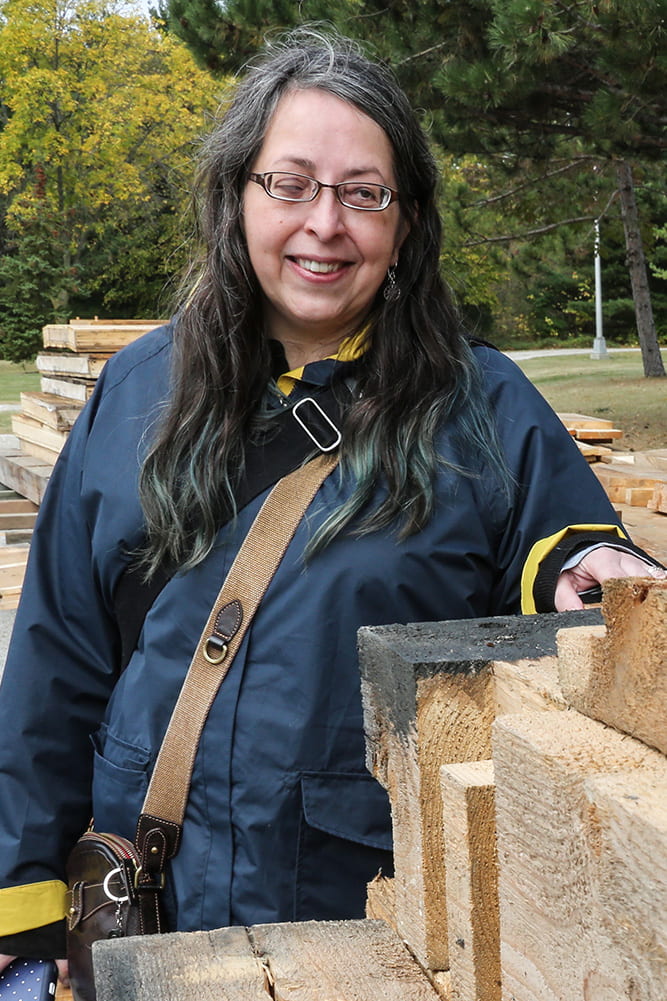An Unlikely Time Machine

UW-Green Bay’s new Viking House transports visitors to medieval Norway
The first glimpse of the low, wooden structure sitting alone near Wood Hall gives no clue it is, in a sense, a time machine, ready to transport visitors 1,000 years into the past, to experience daily life in medieval Scandinavia.
This is the Viking House, a 14-by-28-foot replica of the trestle-frame construction style called grindbyggning (GRINNED-big-ning), common in Norway. Until summer 2017, the house sat in Central Wisconsin on land owned by Owen and Elspeth Christianson.
When they retired in 2016, the Christiansons donated the house to UW-Green Bay, largely due to their strong friendship with Prof. Heidi Sherman (Humanities and History), who had taken many students to the Viking House in recent years for its hands-on experience living in the Viking Age.

Prof. Sherman prior to construction
with Viking Long House beams.
“Most college students say they learn best through hands-on learning,” said Sherman, “and that’s what the Viking House offers. These opportunities are the biggest draw of the house, especially in the cyber age, when people feel disconnected from basic skill sets like sewing, woodworking or cooking over an open fire.” Students from Sherman’s Public Humanities class spent three days in mid-September working with the Christiansons to carefully mark each piece and disassemble the building for its journey to Green Bay. Today, the Viking House rests comfortably on the campus site with authentic green slate shingles, timber painted with black tar and beams secured with wooden pegs.
Once inside, a visitor is transported to medieval Scandinavia. The interior is dark, lighted only by the filtered sun shining through the open front door and a two-foot square vent in the ceiling, above a central hearth.
The five grinds — each a separate post-and-beam trestle — reach to the peak of the ceiling and extend from the front door to the back of the house. These grinds are the elemental structures that give grindbyggning construction its name.
“The size of these structures symbolized the power and wealth of their owners,” said Kevin Cullen, deputy director of Green Bay’s Neville Public Museum. “The engineering provides exceptional load-bearing capacity and ample interior space. The conifer timbers in the fjords of the Baltic Sea region would have allowed Viking craftsmen and craftswomen to hone their architectural construction methods.” Standing in the dim sunlight, one can imagine living here. The wood-fired hearth would be used for heat and for cooking. At mealtime, a small dining table hanging at the far end of the house would be taken from its hooks and set on two carved trestle legs. Fabric would be woven on the vertical loom resting in one corner of the room. The family would sleep on the slatted beds near the hearth, while the family’s livestock settled in a similar room adjacent to this one.
It was an experience like this that had a major impact on UW-Green Bay graduate Ryan Matsen ’16, who is a history teacher at Holy Family School in Green Bay.
“The trip to the Viking House in 2012 showed me what type of history teacher I wanted to be,” said Matsen. “The weekend trip taught us weaving, cooking and blacksmithing, and I used that blacksmithing experience as my central research theme to complete that semester’s History Seminar course.”
“Reliving history through hands-on learning is such a wonderfully interactive way to teach students of literally all ages,” he continued. “Combined with educators who have true energy and passion for their subject matter, it creates an amazingly conducive learning environment. Having this resource for the education of all UW-Green Bay students and our region is absolutely wonderful.” These are the experiences Sherman and others in the community plan to create.
“We have already had several inquiries from the community about booking the house for special events and education seminars,” she said. “We will host several master craftsmen, blacksmiths, leather workers and a culinary archaeologist from Sweden. They will offer workshops for the community and students. We hope to offer a summer Viking camp for Green Bay district students and a workshop for Scouts to help them earn their archaeology badge.”
“UW-Green Bay is fortunate to have such a unique outdoor classroom,” said Neville’s Cullen. “It offers a rare opportunity for immersive teachable moments about Viking life. It also offers an ideal space to conduct experimental archaeological courses like textile manufacturing, cooking, ale brewing and metalsmithing. When I mentioned the Viking House to a former graduate school instructor, she was jealous! I hope this is the beginning of many collaborative learning opportunities to come.”
–Story by Jim Streed ’03



